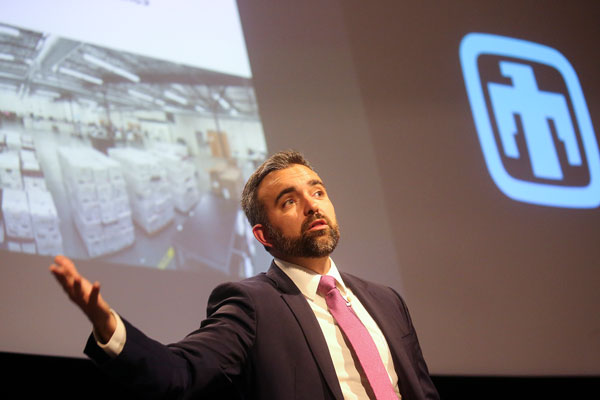D.A. Torrez updates Sandia on crime in Albuquerque

District Attorney Raúl Torrez returned to Sandia just over a year after his eye-opening talk on crime in the Albuquerque area to update the workforce on the successes and challenges still faced by his organization in dealing with Albuquerque’s ongoing crime problems.
Torrez began his talk by reiterating how bad crime was in Albuquerque when he arrived in the office in 2017. During a time when most cities were enjoying a decrease in crime, Albuquerque was on the opposite path. As compared to the 30 largest cities in America, over two years, Albuquerque was ranked first in increases in homicide (102%), and first in increases in crime, violent crime and property crime (26% each).
In the past two years, Albuquerque crime levels have decreased overall, though Torrez admits that it’s sometimes hard to see that on the ground.
“This is still a very dangerous community, and it’s one that is facing serious challenges,” Torrez said, adding that “a lot of the work that has been going on is starting to have a measured impact on total crime.”
Since 2017, Torrez said he and his team have worked with a sense of urgency in reversing those trends, which isn’t easy when faced with heavy caseloads and the slow-changing nature of government organizations.
Data-driven prosecution depends on … data
One of Torrez’s goals is looking for ways to mine the D.A. data and the data of other law enforcement organizations to better focus its efforts on the small number of people who commit the most crimes and also the most violent crimes.
Torrez said he inherited offices full of boxes of paper documents going back decades, cluttering up space intended for attorneys and special victims services, the result of chronic underinvestment in the information infrastructure that supports the criminal justice system. This underinvestment also means that valuable data from decades of cases has not been added to case files.
In the past, Torrez said, if information wasn’t directly relevant to a trial, it didn’t find its way into the database.
“Unlocking the data in those boxes unleashed things like phone numbers, addresses, known associates, references and identifiers for firearms and automobiles, which can connect different people in this community who are committing crimes,” Torrez said.
In addition to data not making it into the D.A.’s database, the criminal justice system in New Mexico includes five to seven primary databases that didn’t directly communicate with each other.
With the space freed up from digitizing the boxes of paperwork, the office has created the first Victim Resource Center, a place for families who are victims of crimes to gain access to resources like counseling and law enforcement support.
Adolfo Mendez and Paul Crickard from Torrez’ office discussed how they’ve worked with Sandia volunteers as well as partners from New Mexico Tech and the MIND Institute to use data analytic techniques like network analysis to find ways to better visualize crime data and identify key people and organizations that drive crime in the metro area.
It’s this data-driven prosecution that Torrez hopes will allow his office to speed up the process from arrest to prosecution and focus attention on key repeat offenders who account for much of the serious, violent crime.
Speed, certainty and severity
Torrez jokingly suggested that the key to dealing with criminals is similar to dealing with children.
“I have a 6-year-old at home who fails to meet his key performance indicators on a regular basis,” Torrez said, garnering laughter from the crowd. “When my 6-year-old does this, do you think it’s good to threaten them with severe punishment that is highly unlikely to happen a year and half from now, or something that happens quickly?”
One of the contributors to crime can be the time it takes to initiate a case and see it all the way through to prosecution. Torrez said that at the lowest point, it took as long as 221 days from arrest to the initiation of a criminal case. Response to criminal cases with speed and certainty needs to occur in 30, 60 or 90 days, he said, rather than focusing on the severity of the sentence down the line.
“Whenever you’re talking about crime, you invariably talk about punishment. Severity has limited impact in deterring criminal activity. Sometimes we tend to overvalue them at the expense of speed and certainty,” Torrez said.
Hoping to fix this, legislators cut in half the amount of time the state has before it can initiate a case, but they did not fund additional resources to support that faster cycle, Torrez said. Now, with additional resources and by prioritizing speed, that time period has been reduced to about 28 days.
Frequent fliers
In the past two years, Torrez’s office has begun making inroads on its goal of mining available data for ways to pivot a system that historically treated each crime chronologically into one that can focus its resources on the “overachievers” who most greatly contribute to Albuquerque’s crime problem.
Torrez said 26% of those arrested have been arrested three or more times, and they comprise 62% of arrests. Repeat offenders also grow increasingly violent the more times they are arrested.
“It’s these high-impact overachievers who are driving the issue. That’s the core of the problem,” Torrez said. “People who strive to be high-impact overachievers deserve special attention. We’re going to give them the best customer service.”
Data-driven prosecution allows cases involving these repeat, violent offenders to be prioritized, lessening the opportunity cost associated with handling all cases equally and chronologically.
Following Torrez’ talk, Sandia researcher Rudy Garcia discussed his passion and commitment to the volunteer work he and other Sandians do to help with Torrez’ data-mining efforts.
Employees can watch a video of the talk on Sandia’s digital streaming library.
See also: DA talks tough on metro crime
Interested in volunteering?
Visit the Bernalillo County Victims Service Alliance website for more information. Employees can also learn more about Sandia’s technical volunteer work.